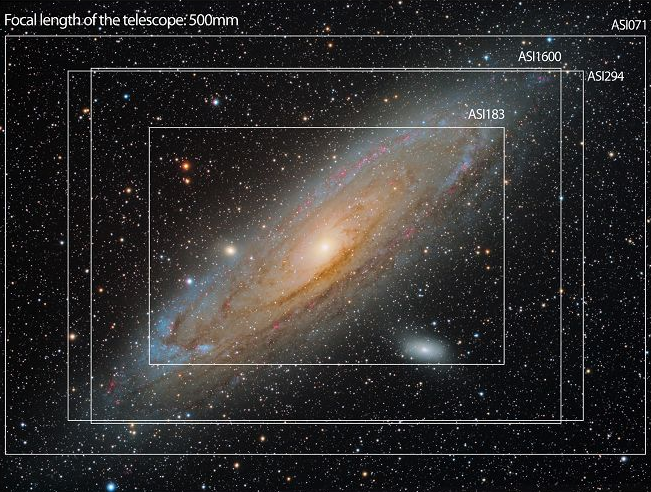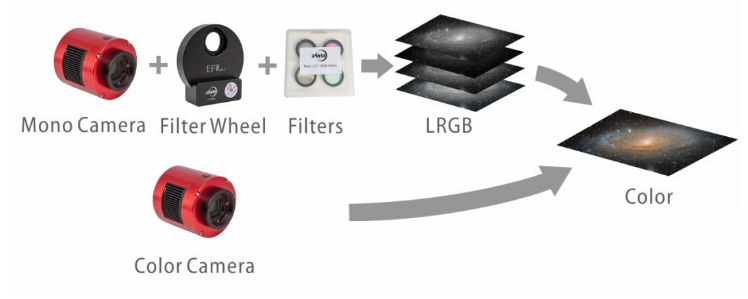Many can confirm that deep space imaging is not the easiest of hobbies, but it is the most rewarding! We want to make this hobby as simple as possible for you, to do this, ZWO offers a lot of what you need to get started on your deep space journey!
What You Need (Offered by ZWO)
1. Deep space camera
2. Acquisition software/hardware – ZWO ASIAIR
3. Filter Wheel and Filters (optional)
4. Electronic Focus (optional)
5. Guide scope/Off-Axis Guider
6. Guide Camera
What You Need (Not Offered by ZWO)
1. Telescope or Camera Lens
2. GOTO, Electronic Tracking Equatorial Mount
Choosing a Camera

There are several different factors to consider when choosing a deep space camera:
Choosing a framing/field of view
There are two parts of your imaging rig which influence your field of view, those are; your telescope focal length and the size of the sensor on your camera. You may want a camera with a smaller chip to image small galaxies with and a larger chip will be useful for big nebula. Here is an example of the field of view for four different ZWO cameras in the same telescope.

Colour or Black and White Camera
Both cameras have their advantages, a colour camera does not take as much time to get a final image and is simpler to use and process. A black and white camera requires filters to separate wavelengths of light to later combine into a colour image. If you are wondering why would you go through the extra effort of a black and white camera, their sensors are more sensitive, meaning the quality of the final image is often better quality.

Pixel Size
Certain cameras work better with different telescopes. Depending on the focal length of the telescope you may want smaller or larger pixels. Typically, larger pixels work best with longer focal lengths.
ZWO Deep Space Cameras
With an APS-C size sensor, this camera has one of the largest fields of view supported by most telescopes. With low amp glow and low noise, this is an excellent camera for long exposures.
ASI294MC PRO
A great bang for buck, colour deep space camera. With the Sony IMX294 back-illuminated CMOS sensor. This camera is capable of stunning deep space images.
ASI1600MM PRO
The ASI1600MM PRO has become the most popular black and white deep space camera for a reason. With extremely low noise, this camera can blow anyone’s mind with stunning detail of deep space.
ASI183MM/MC PRO
The ASI183MM/MC PRO can take your short focal length telescope deeper than ever. With a high-resolution small sensor and ultra-high quantum efficiency both the colour and black and white versions of this camera compete with the big sensors! Not to mention this camera can double up as a planetary/solar camera using ROI.
ZWO’s PRO series of cooling cameras have the following common features:
1. DDR3 256MB cache
2. USB3.0 high-speed data transmission
3. USB2.0 Hub
4. Double-layer semiconductor constant temperature cooling
5. AR multi-layer anti-reflective coating sealing window


I am looking at either ASI1600GT or ASI1600mm Pro Cool. With the GT, there is a built in filter wheel that accept 1.25″ filter. I know if I was to purchase the Pro Cool camera, I would need to purchase the filter wheel. Aside from that, is there an advantage of one over another? My intention is to use the camera for DSO in conjuction with ASIAir and mini guide scope with my Stellarvue SV102 refractor. Are there any pro and con between them?
1
0
GT version camera just combine the EFW and the camera togther.
2
0
I currently own an 8″ sct by meade and an avx mount. I also have the asiair and an asi224mc camera. I keep reading that the 224 is better suited for guiding because of its chip size. What camera would you reccomend for my set up that wouldnt break my bank account. Looking at 6 – 800 dollar expense.
5
0
How about ASI294mc? the chip size is 19.1×13.0mm.
1
0